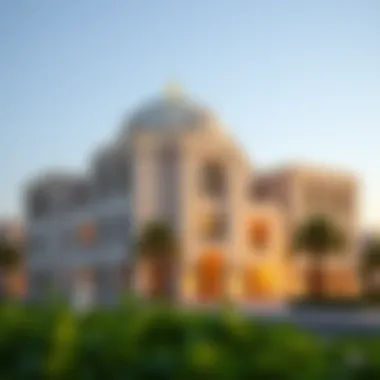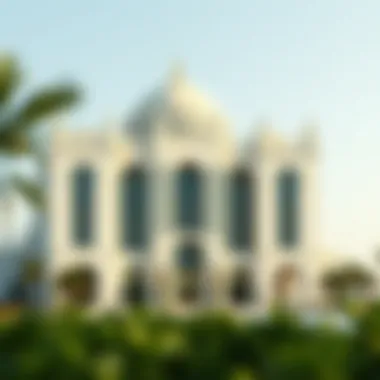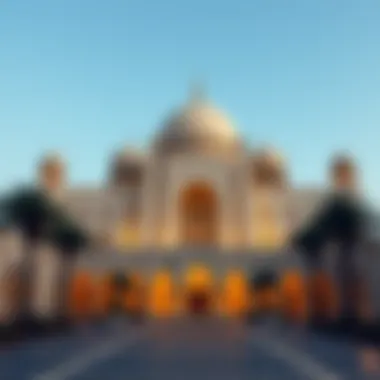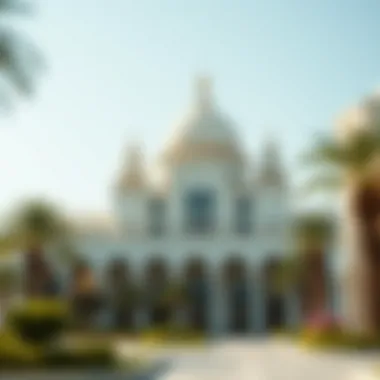Key Architectural Landmarks in the UAE


Intro
The United Arab Emirates stands as a beacon of architectural innovation and cultural fusion, where the past meets futuristic aspirations. From the winding alleys of ancient souks to sparkling skyscrapers touching the clouds, this nation tells a compelling story through its buildings. Each structure reflects not only the architectural prowess of its time but also the bustling spirit of its community.
In today's fast-paced world, understanding the significance of these architectural works goes beyond mere aesthetics. They hold the cultural essence of the nation and serve as pivotal landmarks for real estate development and tourism. As we traverse through the significant architectural works in the UAE, we will peel back the layers of history and innovation that shape the landscape. Investors, homebuyers, and property managers alike will find insights into how these structures influence market trends, property values, and future developments.
The journey starts by exploring the current market trends that define the real estate environment, delving into property prices and the influx of upcoming developments that signal growth and opportunity.
Preface to Architectural Significance in the UAE
In the United Arab Emirates, architecture is more than mere construction; it is a profound reflection of the nation’s heritage, aspirations, and identity. The buildings and structures dotting the skyline of cities like Dubai and Abu Dhabi embody a fusion of tradition and modernity, signifying a remarkable story of transformation. Understanding this significance is crucial for anyone invested in the UAE’s real estate market or tourism sector.
The architectural landscape of the UAE serves as an immense canvas that illustrates the rapid growth and evolution of this young nation. Throughout its relatively short history, the UAE has transitioned from humble beginnings rooted in Bedouin culture to becoming a global hub characterized by futuristic skyscrapers and intricate cultural landmarks. These architectural feats are emblematic of the Emirati vision, showcasing innovation while honoring traditional influences.
Key Elements of Architectural Significance
- Cultural Identity: The structures not only serve functional purposes but are also symbols of the Emirati cultural narrative. Buildings like the Sheikh Zayed Grand Mosque reflect Islamic architectural principles, while others emphasize the multicultural aspect of the society.
- Economic Impact: Iconic buildings significantly bolster the UAE’s economy. The investment in architectural marvels draws international tourism and stimulates local commerce, presenting lucrative opportunities for real estate agents, investors, and property managers alike.
- Urban Development: Thoughtful architectural design plays a pivotal role in urban planning. The integration of green spaces, smart innovations, and community areas elevates living standards and attracts residents and visitors.
Considerations in Discussion
While discussing architectural significance, it’s crucial to examine the following:
- Sustainability: With a growing focus on sustainable development, future architecture in the UAE is leaning toward eco-friendly designs and materials, making it relevant in discussions around global environmental concerns.
- Technological Integration: As we delve deeper into modern architectural trends, technology's role cannot be overlooked. Advancements in construction techniques and smart city concepts are reshaping the skyline.
This section sets the stage for a deeper exploration into the historical context and contemporary achievements that define the UAE’s architectural identity. The subsequent sections will unravel the layers of this identity, examining how each structure contributes to the wider narrative of the nation’s progression and aspirations.
Historical Context of UAE Architecture
Understanding the historical context of architecture in the United Arab Emirates sets the stage for a nuanced appreciation of its current landscape. The UAE boasts a rich tapestry woven from a blend of traditional and modern influences, which together tell the story of an evolving civilization. Delving into the architecture not only illuminates the physical structures but also reveals social, economic, and cultural nuances inherent to the region.
The significance of this exploration stems from its ability to highlight how various historical factors have shaped present-day architectural practices. By tracing the roots of UAE's architectural evolution, one can understand how ancient traditions coexist and harmonize with cutting-edge design, providing valuable insights for real estate agents, investors, and property managers alike.
Influence of Bedouin Culture
The Bedouin heritage has played a profound role in defining the architectural narrative of the UAE. Traditionally, Bedouins lived in tents known as "bayt al-sha'ar," which were crafted from goat hair and designed to be portable. This practical approach to shelter stemmed from a nomadic lifestyle, necessitating structures that could be assembled and disassembled with ease.
Characteristics related to Bedouin architecture include:
- Simplicity: The structures' utilitarian nature reflected the harsh desert climate and the need for efficient living.
- Environmental Harmony: Bedouins harmonized their designs with nature, employing local materials that blended with their surroundings.
- Social Cohesion: The layout of tents and communal areas fostered strong family ties and community involvement, visible even in contemporary developments.
This cultural influence extends beyond mere construction techniques; it represents the resilience of a people whose values continue to permeate the modern architectural ethos of the UAE. The dichotomy between traditional forms and modern interpretations showcases how rich heritage informs contemporary identities.
Colonial Impact on Design
Colonialism introduced new architectural concepts, resulting in a paradigm shift that profoundly altered the UAE's built environment. The period of European influence during the 19th and early 20th centuries brought with it a wave of foreign styles that clashed with indigenous practices.
In addition to the aesthetic transformations, colonialism also facilitated infrastructural advancements, such as roads and ports—critical for evolving trade routes in a globalized world. Some key influences include:
- Adaptation to Local Needs: While colonial styles might seem antithetical to Bedouin architecture, adaptions emerged. Local materials and climate considerations often modified the original designs. For instance, the use of coral stone became prevalent in coastal areas, echoing European styles while serving practical purposes.
- Civic and Administrative Structures: The establishment of governmental institutions led to the construction of significant public buildings, laying foundations for what would evolve into vibrant urban centers.
- Cultural Exchange: Colonial architecture sparked conversations about identity, leading to a blending of styles that became unique to the Arabian Gulf region.
The impact of colonialism can still be felt today—largely as a mixture of traditional aesthetic with modern function, creating a distinct architectural identity that reflects the UAE's past and its aspirations for the future.
"Architecture is the frozen music of a society; it describes where we have come from and where we are going." This quote resonates deeply when considering the architectural evolution within the United Arab Emirates.
Iconic Structures in Dubai
Dubai's skyline is not just a random collection of buildings; it's a reflection of ambition and innovation molded by the region's rapid development. The iconic structures here act as pillars that hold up the narrative of a city transforming itself from a modest trading post into a global hub of commerce, tourism, and culture. m These architectural marvels serve a dual purpose—showcasing incredible design while meeting functional needs of a fast-growing population.
Burj Khalifa: A Testament to Innovation
Standing at a staggering 828 meters, the Burj Khalifa isn't just the tallest building in the world; it symbolizes the UAE's relentless pursuit of excellence. Designed by the architectural firm Skidmore, Owings & Merrill, this skyscraper redefines what a modern city can achieve. Its primary materials—reinforced concrete and steel—are evidence of the thoughtful engineering that went into overcoming the challenges of such a height.
"Architecture is about making the invisible visible. The Burj Khalifa makes a bold statement about what's possible when design and engineering come together."


The iconic structure's design draws inspiration from the desert flower Hymenocallis, creating an elegant, spiraling form that’s both beautiful and functional. It houses a mix of residential, commercial, and hospitality spaces, allowing diverse utilization unmatched in other urban centers.
The Dubai Mall: More than a Shopping Experience
When one thinks about malls, they often picture large stores with endless rows of products. However, the Dubai Mall transcends this stereotype. Announced in 2003 and opening its doors in 2008, it is more akin to a community hub. Covering over 1.1 million square meters, it features not just shopping outlets but also an aquarium, an ice rink, and various restaurants. The design philosophy here is smooth integration with the surrounding environment, enhancing the overall visitor experience.
For investors and property managers, the success of the Dubai Mall translates into real estate opportunities. It’s not just a mall; it’s a magnet that draws millions of visitors each year, making it a cornerstone for economic activity.
Palm Jumeirah: Engineering Marvel
Often described as the eighth wonder of the world, Palm Jumeirah encapsulates the heights of human engineering. This man-made island, shaped like a palm tree, sits off the coast of Dubai and showcases the capability of modern engineering techniques.
Developed initially by Nakheel, the island includes luxurious hotels, upscale apartments, and beachside villas. It's an exemplar of luxury living merged with innovative architectural design, making it incredibly attractive not just for tourists, but also for buyers looking for an exclusive lifestyle.
The construction of Palm Jumeirah was not without its trials. It required advanced technology to manage the island's unique shape and structural integrity. Investors interested in the UAE real estate market often see this marvel as both a residential opportunity and a hallmark of the region's ambitious projects.
In summary, the iconic structures in Dubai are not mere buildings but reflections of a city that dreams big. They contribute significantly to the economy, influence lifestyle choices, and turn the urban landscape into a work of art. These structures speak to the vision and drive of the UAE, drawing in visitors from all corners of the globe while encouraging investment and real estate growth.
For further reading, you can explore resources at Britannica, or for specifics about architecture in the UAE, visit Wikipedia.
Learning about how structures like the Burj Khalifa, Dubai Mall, and Palm Jumeirah have shaped not just a city, but an entire nation can provide valuable insights into real estate opportunities and cultural integration in this unique region.
Cultural Landmarks in Abu Dhabi
Cultural landmarks in Abu Dhabi serve as the backbone of the emirate's architectural and social identity. These structures are not just bricks and mortar; they embody the rich heritage and collective aspirations of the community. By focusing on places like the Sheikh Zayed Grand Mosque and the Louvre Abu Dhabi, we illuminate how these sites foster intercultural dialogue, celebrate the UAE's cultural diversity, and contribute to a collective sense of belonging.
Sheikh Zayed Grand Mosque: A Symbol of Tolerance
The Sheikh Zayed Grand Mosque stands as a paragon of Islamic architecture and a vivid representation of tolerance. Completed in 2007, this mosque is more than just a place of worship; it's an open invitation for people of all faiths to explore and understand the depth of Islamic culture. With its 82 domes, over 1,000 columns, and the world’s largest hand-knotted carpet, it showcases both artistry and craftsmanship.
Architectural Features
- Dome Design: The mosque's large central dome is reminiscent of styles from both Ottoman and Mughal architectures, reflecting the blend of influences that shape the UAE.
- Minarets: It boasts four grand minarets, each intricately designed and adding to the mosque’s ethereal beauty. These structures not only serve a functional purpose but also add a serene aesthetic appeal.
- Interiors: Inside, the lavish use of white marble and gold leaf creates a tranquil atmosphere. The intricate carvings and calligraphy tell stories that resonate deeply with visitors.
Community Impact
Sheikh Zayed Grand Mosque's significance extends into community engagement. The mosque welcomes millions of visitors annually, thereby contributing to tourism while fostering an environment for interfaith dialogue. Educational programs and guided tours allow guests to deepen their understanding, promoting respect and unity among diverse populations.
"The Sheikh Zayed Grand Mosque is not just a religious site; it's a celebration of harmony and community spirit that stands as a beacon of tolerance in the UAE."
Louvre Abu Dhabi: Bridging Cultures
The Louvre Abu Dhabi, inaugurated in 2017, is an innovative cultural institution on Saadiyat Island that acts as a bridge between various civilizations. It highlights the interconnectedness of cultures through art and history. This landmark is a shining example of how contemporary architecture can honor the past while looking to the future.
Design and Architecture
- Architectural Vision: Designed by the Pritzker Prize-winning architect Jean Nouvel, the museum features a stunning dome that creates a "rain of light" effect, mimicking the interlacing patterns often found in Islamic design.
- Exhibitions: It houses a rich collection of artworks and historical artifacts, including pieces from ancient Egypt to modern times. This imported variety tells stories that span geography and epochs.
Cultural Significance
The Louvre Abu Dhabi is more than just an art gallery. It serves as a cultural hub where diverse narratives converge. The museum aims not only to showcase esteemed works but to create a dialogue about global history. Its presence is significant for real estate agents and investors in the area; it raises the profile of Abu Dhabi as a cultural capital, which inherently boosts local tourism and by extension, residential desirability.
- Education Programs: Workshops and events engage local communities, bridging gaps between different cultural backgrounds.
- Global Collaboration: The museum's partnership with the French Louvre symbolizes deep cultural ties, enhancing the UAE's image on the world stage.
In essence, the cultural landmarks of Abu Dhabi, particularly the Sheikh Zayed Grand Mosque and the Louvre Abu Dhabi, not only reflect the architectural ingenuity and artistic expression of the region but also underscore the importance of tolerance, education, and cultural exchange in an increasingly interconnected world.
Historic Sites Reflecting UAE Heritage
The historical sites in the UAE serve as a tangible reminder of the rich cultural tapestry and traditions that have influenced the region's architectural evolution. These locations are not merely relics of the past; they offer valuable insights into the lives of those who came before us, illustrating how architecture has always mirrored societal transformations and cultural interchanges. By studying these sites, one not only grasps the historical context but also appreciates the values and artistry that defined different eras in the UAE.
Among the notable benefits of preserving these historic sites is their potential to enhance tourism, a vital aspect driving the UAE's economy. As visitors wander through the remnants of ancient forts, oases, and bustling trade routes, they engage with history in a manner far more profound than what is offered through textbooks or guided tours. In this way, heritage sites ignite curiosity and appreciation among both locals and global tourists alike.
Moreover, local communities thrive around these landmarks; they become centers for cultural activities and events, fostering a sense of identity and belonging. The ongoing efforts to maintain and promote these historic sites demonstrate a clear commitment to heritage conservation, ensuring that the lessons and legacies of the past guide future development.
Al Ain Oasis: A Window into the Past


Al Ain Oasis is one of the earliest forms of urban settlement in the UAE, dating back thousands of years. This expansive green area, dotted with palm trees and traditional falaj (irrigation channels), highlights the ingenuity of ancient agricultural practices. It is here that visitors can stroll along shaded paths while reflecting on how life flourished in harsh desert conditions.
The oasis is a UNESCO World Heritage site, symbolizing the collaborative spirit of the Bedouin tribes and their innovative water management systems. A key feature of Al Ain is how it harmonizes with the natural surroundings, showcasing sustainable living long before the concept became a modern trend. The architectural layout, characterized by mud-brick structures, reflects a keen understanding of environmental adaptations, as well as an appreciation for aesthetic simplicity.
"Al Ain Oasis embodies a rich agricultural heritage, a testament to the resourcefulness of those who resided there."
Visitors to the oasis can delve into its history at the Al Ain Oasis Visitor Center, where interactive exhibits detail the significance of this lush sanctuary. The opportunity to engage with local flora and experience the traditional date-picking rituals adds a sensory experience that further connects one to the region's past.
Dubai Creek: The Heart of the City
Dubai Creek acts not just as a waterway but as a vital artery that has sustained and shaped the city for centuries. Historically, it was the heart of Dubai's thriving trade and pearl diving industries, facilitating commerce with neighboring countries. This stretch of water encapsulates the dynamic growth of Dubai from a small fishing village to the global metropolis it has become today.
The architecture surrounding the creek tells its own tale—mixing traditional dhows and modern yachts, where old-world charm meets new-age luxury. Incursion by towering buildings reflects the ambitious skyline Dubai is known for, yet the old souks and heritage areas, like Al Fahidi Historical Neighborhood, are reminders of the city’s origins.
Walking along the banks of the creek, you can see how people interact with water in their daily life, whether it's local fishermen casting nets or families picnic-ing on the banks. The Dubai Creek is also the launching point for boat tours that provide a unique perspective on the city, offering glimpses of the blend between modern and historical architectures that define Dubai's character.
Ultimately, both Al Ain Oasis and Dubai Creek cmdime the narrative of the UAE's heritage, showcasing enduring connections between past practices and contemporary lifestyles. As the nation moves forward, such sites remain essential, preserving the memory of a culture while paving the way for future innovations.
Modern Architectural Trends
Modern architectural trends in the UAE are not just about aesthetics; they're pivotal in shaping the urban landscapes where millions live, work, and interact. These trends reflect the country's rapid development and globalization while being rooted in sustainable practices and cutting-edge innovation. They serve as a guide for future construction and city planning, addressing not only the needs of the present but also considering the long-term impacts on the environment and the community at large.
Sustainable Design in the Urban Landscape
Sustainable design has taken center stage in UAE architecture, driven largely by the pressing need to address climate concerns and the effects of rapid urban expansion. Green buildings, which utilize resources efficiently, promote a healthy environment for inhabitants, and minimize impact on the natural surroundings, have become a hallmark of modern development. Examples of such initiatives include the Masdar City project in Abu Dhabi, aimed at becoming a hub for sustainable living and renewable energy solutions.
Key elements of sustainable architecture in the UAE include:
- Use of Renewable Resources: Incorporating solar panels and other renewable energy sources helps in lowering energy consumption, aligning with the country’s vision for sustainable growth.
- Water Conservation Strategies: Buildings are designed with systems to recycle and conserve water, critical in arid regions like the UAE.
- Heat-Resistant Materials: The choice of materials that reduce heat gain and are environmentally friendly is essential to combat the desert climate.
The benefits of such sustainable design practices go beyond environmental advantages; they also cater to economic factors, being cost-effective in the long term by reducing energy and maintenance costs.
Integration of Technology in Architecture
The integration of technology in architecture within the UAE is transforming the construction landscape into a realm of unparalleled possibilities. Architectural firms are increasingly leveraging advanced design software, Building Information Modeling (BIM), and smart building systems to enhance the performance of structures.
Smart buildings incorporate various technologies to improve energy efficiency and enhance occupant comfort. For instance, buildings equipped with IoT devices can automatically adjust heating, cooling, and lighting based on real-time occupancy data. This approach not only fosters a more responsive environment but also significantly cuts down on resource waste.
Furthermore, drones and 3D printing are changing how architects visualize and execute their designs. Here are some key aspects of tech integration:
- Visualization Tools: Advanced simulations enable architects to visualize their projects in a digitally constructed environment, enhancing accuracy and efficiency in the design phase.
- Structural Monitoring: Sensors embedded in buildings can monitor structural integrity over time, predicting maintenance needs and increasing safety.
- Automation: Automated systems for lighting and temperature control lead to improved energy efficiency, which is especially important in regions where energy costs can escalate quickly.
"Architecture is not just about creating new buildings; it’s about designing the future in a sustainable way."
For more insights on sustainable design, visit sustainablearchitecture.com.
To learn about smart technologies, check out smartbuilding.com.
Impact of Tourism on Architectural Development
The interplay between tourism and architectural development in the UAE is a compelling narrative. The sheer scale of architectural projects linked to tourism has transformed cities like Dubai and Abu Dhabi into global icons. This section elucidates how tourism both fuels architectural innovation and shapes urban landscapes, creating structures that are not just buildings but landmarks that represent the cultural and economic aspirations of the region.
Attracting Global Visitors
As the UAE positions itself as a leading global tourist destination, the architecture plays an integral role in attracting visitors from around the world. The Burj Khalifa, for example, offers more than a breathtaking view; it serves as a testament to Dubai's ambition and draws over 1.5 million tourists annually to its observation decks. Similarly, the Louvre Abu Dhabi has harnessed its architectural significance, inviting art lovers globally to witness a blend of cultural heritage and modern design.
Key points include:
- Iconic Design: Structures that exemplify unique architectural styles enhance the city's profile and allure.
- Cultural Exchange: A diverse visitor demographic fosters cultural appreciation through architectural experiences.
- Event Hosting: Landmark buildings often host global events that further promote tourism and engagement.
By crafting environments that entice global visitors, the UAE's architectural landscape is not simply about aesthetics. It is constructed to create memorable experiences that linger in the minds of travelers, prompting them to return and share their experiences with others.
Economic Contributions of Landmark Structures
The economic impact of architectural projects extends beyond their initial construction. Consider the Dubai Mall, an architectural feat, it generates an estimated $20 billion in annual revenue. This landmark not only houses shops and entertainment but acts as a crucial driver of the local economy.
Other considerations include:
- Job Creation: Large-scale constructions lead to thousands of job opportunities, from engineers to hospitality workers.
- Urban Development: As architectural marvels rise, they prompt the growth of surrounding areas, developing new business hubs and enhancing local businesses.
- Tax Revenue: Increased tourism translates into higher tax revenues, which can be reinvested into public services and infrastructure.


"Architecture is the brilliant juxtaposition of artistry and functionality, essential for fostering a thriving tourism sector."
Future Outlook: Innovations in UAE Architecture
The architectural landscape of the UAE is poised at a striking juncture where tradition meets cutting-edge innovation. As the country continues to evolve, the future of architecture here hinges on breakthroughs that embrace sustainability, smart technologies, and community-centric design. Recognizing the significance of this trend is crucial for professionals in real estate and urban development, as these elements will profoundly affect investment opportunities and living experiences in the upcoming years.
Emerging Design Philosophies
One cannot overlook the growing emphasis on sustainable design philosophies. Acknowledging the environmental footprint of traditional construction practices has become paramount. The UAE is notably shifting toward designs that not only consider aesthetics but also environmental impact.
Energy-efficient buildings, which incorporate higher insulation levels and energy-saving technologies, are becoming standard. New projects like the Masdar City in Abu Dhabi serve as exemplars of sustainability, aiming to be a zero-carbon city that harnesses renewable energy sources. This project represents a commitment to reducing reliance on non-renewable energy, making it a beacon for future developments across the region.
Additionally, architects are now looking at biophilic design principles. Integrating natural elements into urban spaces creates healthful environments that foster well-being. For example, incorporating green roofs, which support local flora and improve air quality, is gaining traction among new urban developments.
Smart Cities and Architectural Advancements
Technology's role in shaping future architectural trends cannot be overstated. Smart cities, powered by interconnected systems and the Internet of Things (IoT), promise to enhance urban living by making cities more efficient and responsive to residents' needs. This endeavor complements the UAE's broader vision to establish itself as a hub of technological innovation.
Imagine smart buildings that dynamically adjust energy usage based on occupancy or weather conditions. These structures utilize advanced sensors and data analytics to reduce energy consumption significantly, providing long-term economic benefits. For instance, Abu Dhabi's Hudayriyat Island project is not just about leisure but integrates smart solutions to promote an enhanced lifestyle while reducing carbon emissions.
Moreover, public spaces are evolving with the integration of digital interfaces that foster interaction and connectivity among residents. Facilities equipped with high-speed internet and augmented reality features make community centers and parks venues for cultural and social engagement. This trend not only satisfies the increasing demand for technological engagement but also encourages an active community lifestyle.
"The integration of technology into architecture reflects society's aspirations for sustainability and enhanced living conditions."
In summary, the future of UAE architecture is shifting towards a blend of sustainability and smart technology. As these philosophies take root, they reshape how projects are conceptualized and developed. For real estate agents and property managers, recognizing these trends can lead to better-positioned investments that resonate with the evolving demands of a discerning clientele.
Significance of Community Spaces
Community spaces in the United Arab Emirates are essential for fostering social cohesion and enhancing the quality of life for residents. These areas serve more than just functional purposes; they are integral components of urban planning that contribute to the cultural and social fabric of society. The UAE, with its nascent urban landscape, understands that community spaces create venues for gatherings, promote environmental sustainability, and encourage active lifestyles.
These spaces offer numerous benefits, including:
- Social Interaction: They act as hubs where people come together, share experiences, and build relationships. From children playing in parks to families enjoying picnics, such environments allow communities to connect.
- Cultural Enrichment: Community spaces often host cultural events or festivals, reflecting the unique heritage and diverse backgrounds of the emirate's population. This not only promotes cultural exchange but also fosters a sense of belonging among residents.
- Environmental Awareness: Incorporating green spaces within urban areas is vital for ecological balance. Parks and gardens help in reducing urban heat, improving air quality, and enhancing biodiversity.
- Health and Well-Being: Access to parks and outdoor spaces encourages physical activity. The availability of amenities like walking paths, sports fields, and fitness stations inspires a more active lifestyle, crucial for the well-being of the community.
In the context of urban development, the importance of community spaces cannot be overstated. They represent the guiding principle of creating inclusive cities where residents feel invested, leading to sustainable community growth.
Parks and Public Amenities
Parks are veritable oases in the bustling urban map of the UAE. They provide serene spots away from the fast-paced city life, where individuals can catch their breath. Notably, Al Mamzar Park in Dubai exemplifies the multi-faceted nature of public parks. It offers everything from sandy beaches to bicycle rentals, merging recreation with relaxation. Facilities like playgrounds tailored for children, BBQ areas for families, and jogging tracks foster a sense of community engagement and healthy lifestyles.
These parks often serve as venues for public events, such as outdoor movie nights or art festivals, allowing local artists and businesses to shine while also drawing people together. Moreover, they encourage a good balance between infrastructure and nature, supporting local wildlife and promoting sustainable practices.
Cultural Centers as Gathering Spaces
Cultural centers in the UAE have carved their niche as pivotal gathering spaces that reflect the nation's commitment to diverse cultures and inclusivity. Institutions like the Sharjah Art Foundation not only facilitate exhibitions and workshops but also encourage dialogues about art and culture among residents and expatriates alike.
Such centers are crucial for hosting discussions, performances, and learning events that contribute to cultural awareness and appreciation. They help break down barriers, allowing different cultural groups to understand each other, resulting in a more integrated society. Furthermore, they often offer access to facilities such as libraries or studios, enhancing education and promoting lifelong learning.
To sum up, the significance of community spaces, be it parks or cultural centers, lies in their ability to bridge gaps between people, enhance well-being, and create vibrant community life. They are not merely amenities; they are essential components that shape the functional and aesthetic experiences of living in the UAE.
"Community spaces cultivate inclusion and diversity, making cities livable for everyone."
For more on the importance of public spaces, you may visit: National Park Service or World Health Organization.
Understanding and investing in community spaces is more relevant than ever, as urban areas continue to densify and evolve, showing that there is more to architecture than just buildings.
Closure: The Architectural Identity of the UAE
The architectural narrative of the United Arab Emirates is anything but ordinary. Over the past few decades, this region has blossomed into a global hub of innovation and heritage in architecture. The unique blend of modern skyscrapers juxtaposed against traditional buildings stands as a testimony to the UAE's growth.
As we've explored in this article, structures like the Burj Khalifa and the Sheikh Zayed Grand Mosque do not merely serve functional purposes; rather, they embody a cultural ethos, reflecting the spirit and aspirations of a rapidly evolving society.
Moreover, the significance of these architectural marvels transcends aesthetics. They play a pivotal role in shaping the identity of cities and communities. Here are several elements that highlight the benefits of this architectural identity:
- Cultural Reflection: Each structure serves as a narrative, telling the story of the UAE's rich history, from Bedouin influences to contemporary designs. For instance, the clean lines and bold statements made by modern buildings showcase the ambition and vision of the Emirates.
- Tourism and Economy: Iconic landmarks drive tourism, bringing visitors eager to experience their grandeur. Economic implications are profound, as these structures create jobs and stimulate growth in various sectors, from hospitality to real estate.
- Sustainability Practices: With global concern over climate change, the UAE is leading initiatives in sustainable architecture that harmonize with the environment. Innovations in green building reflect a forward-thinking approach that prioritizes ecological integrity alongside development.
- Future Developments: As cities transform into smart environments, the architectural framework will increasingly embrace technology, further enhancing the quality of urban life.
*"The built environment shapes our experiences; it influences not just what we see but how we feel and live."
To sum it up, the architectural landscape of the UAE is a dynamic and evolving narrative marked by boldness, heritage, and innovation. The identity crafted through these monumental structures not only defines the skyline but also encapsulates the essence of a nation striving for unity amidst diversity. For real estate agents, investors, and homeowners alike, understanding this architectural dynamic is crucial. It provides context not only for investment opportunities but also for appreciating the cultural backdrop that makes the UAE unique.
By continually merging tradition with cutting-edge design, the UAE sets an example globally, illustrating that architecture can be both forward-thinking and deeply rooted in local culture. As we look toward the future, the potential for architectural innovation remains vast, promising an exciting journey ahead.







